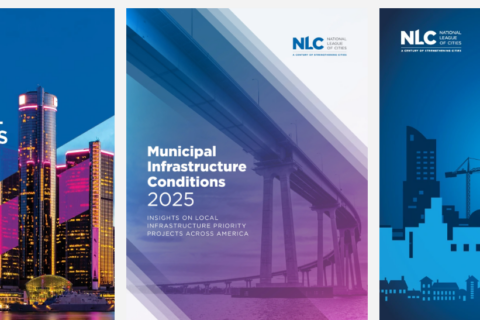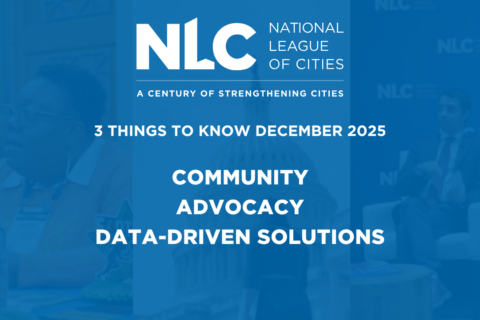This year marks 20 years since Hurricane Katrina exposed major weaknesses in the nation’s disaster response system and forced a reckoning with how FEMA serves communities in crisis. The devastation reshaped federal policy, driving reforms that continue to influence how aid is delivered, how quickly funds flow and how local governments partner with FEMA in times of disaster. Today, we are once again facing significant questions about FEMA’s effectiveness, as Congress and the Administration pursue very different approaches to reforming the agency.
The Fixing Emergency Management for Americans (FEMA) Act of 2025 (H.R. 4669) was introduced by Transportation and Infrastructure Committee Chairman Sam Graves (R-MO), Ranking Member Rick Larsen (D-WA), former Subcommittee lead Republican Daniel Webster (R-FL) and Subcommittee Ranking Member Greg Stanton (D-AZ). The bill represents one of the most significant updates to federal disaster management law in decades. It reorganizes the Federal Emergency Management Agency (FEMA), modernizes disaster assistance programs and changes how aid is delivered to communities.
For cities, towns and villages, the Act introduces reforms that affect how quickly funding arrives, how rules are applied and how residents access support.
Public Assistance Program Reforms
A central part of the Act is reforming FEMA’s Public Assistance (PA) program, which supports local governments in clearing debris, repairing infrastructure and restoring essential services after disasters. Key changes include:
- Block Grants for Small Disasters: A new block grant program covers events that cause $1 million to $10 million in damage but fall short of major disaster thresholds. Funds can be used for debris removal, infrastructure repairs, emergency protective measures and mitigation projects. FEMA must distribute these grants within 30 days of a declaration, with a minimum 75 percent federal cost share.
- Expedited Emergency Work Funding: FEMA must provide up to 25 percent of the approved federal share for emergency work—such as debris clearance and protective measures—within 10 days of a declaration.
- Simplified Closeouts: Smaller projects may close automatically once funds are disbursed, and FEMA must establish timelines for reviewing and approving larger projects.
- Procurement Consistency: FEMA must align procurement requirements with federal standards and issue pre-approved contract templates. Governments that follow FEMA’s guidance are covered by a “safe harbor” from retroactive funding clawbacks.
Individual and Household Assistance
The Act also introduces reforms aimed at making disaster assistance more accessible for survivors. Among the changes:
- Universal Application: Disaster survivors will be able to use a single application for FEMA, Small Business Administration (SBA), Department of Housing and Urban Development (HUD), United States Department of Agriculture (USDA) and Department of Health and Human Services (HHS) assistance programs. This is designed to reduce the need for multiple applications for different forms of aid.
- Improved Notices and Guides: FEMA must issue plain-language, multilingual and mobile-friendly guidance to make information clearer and more accessible.
- Housing Reforms: FEMA gains expanded authority to provide non-congregate sheltering, extend rental assistance and fund housing repairs or partial rebuilds. The Act also allows for state-managed housing recovery programs, giving states discretion to oversee recovery in certain circumstances.
Mitigation and Resilience
The legislation expands opportunities for mitigation and resilience projects to reduce future risks. Provisions include:
- Broader Project Eligibility: FEMA’s mitigation programs may now support projects such as utility resilience, broadband infrastructure and cybersecurity.
- Building Code Incentives: Communities that adopt modern building codes may qualify for higher federal cost shares for mitigation funding.
- Revolving Loan Fund Expansion: The Act grows FEMA’s Hazard Mitigation Revolving Loan Fund program, giving states and local governments access to low-interest loans for wildfire, drought, seismic and cyber risk reduction projects.
Transparency and Accountability
The Act requires FEMA to make its processes more transparent and consistent. These include:
- Public Dashboards: FEMA must publish real-time dashboards showing disaster declarations, funding obligations and reimbursement timelines.
- Appeals Database: A national database of appeals will be created so outcomes can be reviewed and compared across cases.
- Targeted Oversight: FEMA is directed to focus audits on higher-risk projects rather than applying uniform requirements across all jurisdictions.
- Safe Harbor Protections: Local governments that follow FEMA’s approved rules and guidance in good faith are protected from retroactive penalties.
Organizational and Structural Changes
Beyond funding and program reforms, the Act elevates FEMA’s role within the federal government and establishes new offices. Among the highlights:
- Independent Status: FEMA is established as an independent, cabinet-level agency with its administrator confirmed by the Senate.
- New and Codified Offices: FEMA will codify its existing core offices and add new ones, including offices for cyber and emerging threats, equal rights and external affairs.
- Regional Authority: Regional FEMA administrators receive expanded authority to approve projects, expedite funding and coordinate directly with state and local officials.
Local Government Implications
For cities, towns and villages, the FEMA Act of 2025 introduces several practical changes. Local governments may see:
- Faster access to certain categories of funding, particularly for emergency work and small-scale disasters.
- Reduced paperwork and clearer timelines for project closeouts and reimbursements.
- More predictable procurement standards with model contracts and safe harbor provisions.
- Expanded housing and sheltering options that may ease displacement challenges.
- New funding and financing opportunities for resilience projects, including cyber and infrastructure improvements.
- Greater visibility into FEMA’s decision-making through dashboards and appeals databases.
Summary
The FEMA Act of 2025 reshapes how disaster assistance is managed and delivered. While it elevates FEMA’s status within the federal government, the most immediate effects for local governments lie in program reforms—faster reimbursements, streamlined applications, expanded housing options and clearer procurement rules. For residents, the changes are aimed at simplifying access to disaster aid and expanding available support. The law’s full impact will depend on how FEMA implements these provisions and how federal, state and local governments coordinate during future disasters.
As FEMA’s future is debated, the FEMA Review Council—established by executive order—is tasked with examining the agency’s structure and performance. Earlier this month, NLC, along with the U.S. Conference of Mayors (USCM) and the National Association of Counties (NACo), submitted a joint letter of recommendations to the Council, emphasizing the need for faster reimbursements, clearer guidance and stronger federal–local coordination. To ensure city voices remain central in these conversations, NLC has also established a Disaster Management Ad-Hoc Policy Advisory Committee, bringing together local leaders from across the country to shape reforms that strengthen the federal–local partnership in disaster preparedness, response and recovery.
Resources
- NLC Letter to House T&I Committee (PDF)
- Section-by-Section Summary of the Legislation
- CitiesSpeak Blogs on Emergency Management
Stay Informed
Learn more about how NLC is advocating for cities, towns and villages and explore ways to get involved by subscribing to NLC’s bi-weekly Federal Advocacy Update Newsletter.









